Feed aggregator
Monday Musings: Memories On Our Walls
A couple of weeks ago, a dear friend posted on Facebook an image of a photo print she’d purchased from me years ago, along with a caption saying she still considered the image one of the things in her living space that gives her joy. I was flattered beyond words. And I thought of her post this past week as Nancy and I finally got around to putting art on our walls.
We’ve only done the living room and dining room (and our respective offices), but already the house feels more like a home. I am itching to put up more. This week, perhaps.
I am fortunate to have learned photography as a younger man and to have captured a good number of display-worthy photos over the years. And so we have framed images from many of our travels that are, or will be, on our walls — pictures from Australia and New Zealand, from Ireland and the American Southwest, from our former home in Tennessee and from a memorable trip to New Mexico a few years back. I’m currently deciding which photos from more recent journeys I should print and frame next.
I am even more fortunate to be the younger brother of James Coe, a remarkably talented wildlife and landscape painter. Jim’s art is all over our house; in the rooms we’ve decorated so far we’ve hung nine of his paintings and prints. I expect there will be more before long. [By the way, you can read more about Jim and see images of his art at his website.]
 What else have I got? Several years back, while attending a World Fantasy Convention, I bought signed prints of Martin Springett’s marvelous cover art for Guy Gavriel Kay’s Fionavar Tapestry. Springett himself was selling the art and he was a charming and effective salesman! Some twenty years ago, while living in our little town in Tennessee, we became friends with Stephen Alvarez and his family. Stephen is an amazing freelance nature photographer, whose work has appeared in National Geographic, Time, the New York Times, and other high profile publications. He and his wife, April, also happen to be fantasy readers, so we arranged a trade: a complete signed, hardcover set of the Winds of the Forelands books in exchange for a print of a gorgeous night sky photo taken in Arizona. I think I got the better deal.
What else have I got? Several years back, while attending a World Fantasy Convention, I bought signed prints of Martin Springett’s marvelous cover art for Guy Gavriel Kay’s Fionavar Tapestry. Springett himself was selling the art and he was a charming and effective salesman! Some twenty years ago, while living in our little town in Tennessee, we became friends with Stephen Alvarez and his family. Stephen is an amazing freelance nature photographer, whose work has appeared in National Geographic, Time, the New York Times, and other high profile publications. He and his wife, April, also happen to be fantasy readers, so we arranged a trade: a complete signed, hardcover set of the Winds of the Forelands books in exchange for a print of a gorgeous night sky photo taken in Arizona. I think I got the better deal.
 We have a few nice pieces of art that once belonged to my parents. We have photos we purchased just outside of Zion National Park — photos of the park taken by photographer David J. West, with whom we chatted for a time one memorable morning. I have in my office a tiny framed pressed bronze image of a Celtic owl, which I love. And I have yet another signed photo print, this one by renowned nature photographer Larry Ulrich. It was a gift from my siblings for my 50th birthday. And we have a signed print from a Native American artist in the Pacific Northwest that we bought while on our honeymoon in Victoria, British Columbia. This print has hung over the mantel in every home Nancy and I have shared. It was the first piece we put up in the new house.
We have a few nice pieces of art that once belonged to my parents. We have photos we purchased just outside of Zion National Park — photos of the park taken by photographer David J. West, with whom we chatted for a time one memorable morning. I have in my office a tiny framed pressed bronze image of a Celtic owl, which I love. And I have yet another signed photo print, this one by renowned nature photographer Larry Ulrich. It was a gift from my siblings for my 50th birthday. And we have a signed print from a Native American artist in the Pacific Northwest that we bought while on our honeymoon in Victoria, British Columbia. This print has hung over the mantel in every home Nancy and I have shared. It was the first piece we put up in the new house.
 Of course, we have tons of smaller photos all around the house, of our darling daughters, of our parents and siblings, of friends, of our wedding.
Of course, we have tons of smaller photos all around the house, of our darling daughters, of our parents and siblings, of friends, of our wedding.
And I suppose the point of all of this is that every one of these pieces of art, every single thing that I have taken care to center on a wall and hang at the right height and fiddle with until it hangs straight (only to have Nancy come into the room and adjust it so that it really hangs straight) brings me joy. They remind me of places we’ve seen that stole our breath and seared themselves into our memories. They remind me of experiences we cherish and people we love.
Each time we put up something new, it invariably puts a smile on my face.
Take a look around your home, and let the memories stirred by the things you’ve put on your walls bring a smile. And if you care to, share a favorite or two on the Facebook feed for this post.
Have a great week.
Monday Musings: Memories On Our Walls
A couple of weeks ago, a dear friend posted on Facebook an image of a photo print she’d purchased from me years ago, along with a caption saying she still considered the image one of the things in her living space that gives her joy. I was flattered beyond words. And I thought of her post this past week as Nancy and I finally got around to putting art on our walls.
We’ve only done the living room and dining room (and our respective offices), but already the house feels more like a home. I am itching to put up more. This week, perhaps.
I am fortunate to have learned photography as a younger man and to have captured a good number of display-worthy photos over the years. And so we have framed images from many of our travels that are, or will be, on our walls — pictures from Australia and New Zealand, from Ireland and the American Southwest, from our former home in Tennessee and from a memorable trip to New Mexico a few years back. I’m currently deciding which photos from more recent journeys I should print and frame next.
I am even more fortunate to be the younger brother of James Coe, a remarkably talented wildlife and landscape painter. Jim’s art is all over our house; in the rooms we’ve decorated so far we’ve hung nine of his paintings and prints. I expect there will be more before long. [By the way, you can read more about Jim and see images of his art at his website.]
 What else have I got? Several years back, while attending a World Fantasy Convention, I bought signed prints of Martin Springett’s marvelous cover art for Guy Gavriel Kay’s Fionavar Tapestry. Springett himself was selling the art and he was a charming and effective salesman! Some twenty years ago, while living in our little town in Tennessee, we became friends with Stephen Alvarez and his family. Stephen is an amazing freelance nature photographer, whose work has appeared in National Geographic, Time, the New York Times, and other high profile publications. He and his wife, April, also happen to be fantasy readers, so we arranged a trade: a complete signed, hardcover set of the Winds of the Forelands books in exchange for a print of a gorgeous night sky photo taken in Arizona. I think I got the better deal.
What else have I got? Several years back, while attending a World Fantasy Convention, I bought signed prints of Martin Springett’s marvelous cover art for Guy Gavriel Kay’s Fionavar Tapestry. Springett himself was selling the art and he was a charming and effective salesman! Some twenty years ago, while living in our little town in Tennessee, we became friends with Stephen Alvarez and his family. Stephen is an amazing freelance nature photographer, whose work has appeared in National Geographic, Time, the New York Times, and other high profile publications. He and his wife, April, also happen to be fantasy readers, so we arranged a trade: a complete signed, hardcover set of the Winds of the Forelands books in exchange for a print of a gorgeous night sky photo taken in Arizona. I think I got the better deal.
 We have a few nice pieces of art that once belonged to my parents. We have photos we purchased just outside of Zion National Park — photos of the park taken by photographer David J. West, with whom we chatted for a time one memorable morning. I have in my office a tiny framed pressed bronze image of a Celtic owl, which I love. And I have yet another signed photo print, this one by renowned nature photographer Larry Ulrich. It was a gift from my siblings for my 50th birthday. And we have a signed print from a Native American artist in the Pacific Northwest that we bought while on our honeymoon in Victoria, British Columbia. This print has hung over the mantel in every home Nancy and I have shared. It was the first piece we put up in the new house.
We have a few nice pieces of art that once belonged to my parents. We have photos we purchased just outside of Zion National Park — photos of the park taken by photographer David J. West, with whom we chatted for a time one memorable morning. I have in my office a tiny framed pressed bronze image of a Celtic owl, which I love. And I have yet another signed photo print, this one by renowned nature photographer Larry Ulrich. It was a gift from my siblings for my 50th birthday. And we have a signed print from a Native American artist in the Pacific Northwest that we bought while on our honeymoon in Victoria, British Columbia. This print has hung over the mantel in every home Nancy and I have shared. It was the first piece we put up in the new house.
 Of course, we have tons of smaller photos all around the house, of our darling daughters, of our parents and siblings, of friends, of our wedding.
Of course, we have tons of smaller photos all around the house, of our darling daughters, of our parents and siblings, of friends, of our wedding.
And I suppose the point of all of this is that every one of these pieces of art, every single thing that I have taken care to center on a wall and hang at the right height and fiddle with until it hangs straight (only to have Nancy come into the room and adjust it so that it really hangs straight) brings me joy. They remind me of places we’ve seen that stole our breath and seared themselves into our memories. They remind me of experiences we cherish and people we love.
Each time we put up something new, it invariably puts a smile on my face.
Take a look around your home, and let the memories stirred by the things you’ve put on your walls bring a smile. And if you care to, share a favorite or two on the Facebook feed for this post.
Have a great week.
State of the Author, February 2025 edition
Spotlight on “Claire Darling” by Callie Kazumi
She’s been ghosted. But she won’t be forgotten. LitStackers! Line up for this one. In…
The post Spotlight on “Claire Darling” by Callie Kazumi appeared first on LitStack.
Monday Meows
Hello fellow cats, I would like you to meet my fiance, Concretia!
You what now?
Do you think I should tell him?
Naw, it won’t help.
Beware of Greeks Bearing Gifts (and giant wooden horses. I mean, seriously!)
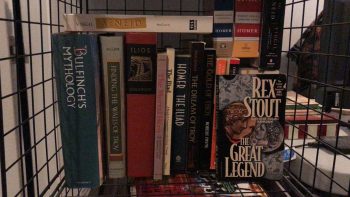 The story of Troy has been my favorite myth since I was a little kid. Greek mythology is far and away my favorite (Norse is a distant second), and I used to check Bullfinch’s out of my grade school library and lug it home. That was a relatively big book. I have my own copy now, of course.
The story of Troy has been my favorite myth since I was a little kid. Greek mythology is far and away my favorite (Norse is a distant second), and I used to check Bullfinch’s out of my grade school library and lug it home. That was a relatively big book. I have my own copy now, of course.
The worst part, is I always root for the Trojans. It never ends well for them. If they had just listened to Laocoon. Though, Athena definitely made that a dangerous proposition…
I’ve used a couple names from Thieves World over the years, in various online RPGs. But hands down, the Iliad has been my main source. Hector, and some variation of Astyanax (I prefer it with more ‘N’ or ‘X’, has far and away my favorite names for fighters (especially paladins). I’ve used a few others, like Penthesilia, Cassandra, and Deiphobus (Helenus just doesn’t work for me).
Way back in pre-Windows days (I think), there was a really cool computer game that included a Troy section. I think you were Jason with his Argonauts, roaming the world. Age of Empires II (man, I played the heck out of that) included a Troy campaign (except I had to sack Troy. Sniff, sniff). There’s a Total War: Troy (kind of a scaled down TW game) that I don’t have yet. You might have read over the past couple weeks that I’m a huge Total War: Warhammer I/II fan.
I don’t do the Assassin’s Creed series, butt there was an Odyssey game, recently. The Odyssey is essentially a sequel to The Iliad. As is Virgil’s The Aeneid.
I read a few translations over the years. But the only version I do now is Robert Fagles’ audiobook. Which, unfortunately, is abridged. I always try to get unabridged versions of books. But for some reason, they never did an unabridged for Fagles. I don’t know what got left out, but it still totally works for me.
I talked about it here, and Derek Jacobi is absolutely FANTASTIC. Probably the best-read audiobook I’ve ever listened to. They had Ian McKellen do Fagles’ Odyssey, and Simon Callow read The Aeneid (Callow is number two, with McKellan still good, but third). Jacobi is nothing short of brilliant.
As I’ve talked about here at Black Gate before, audiobooks let me get to things I otherwise would not read. Old, and new. About once a year, I listen to The Iliad CDs in my car, during the work commute. Some years, I follow it up with The Odyssey. I don’t do The Aeneid that often, but I have listened to it more than once.
The Iliad and The Odyssey are believed to be written not very long apart; both in Greek. As with some of Paul’s Epistles, some think Homer did not author both. I’m just gonna go with ‘Yes, he did.’ The Aeneid as written some six centuries later, in Latin.
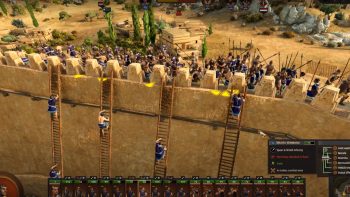 Highly recommend Fagles’ translation, with Jacobi’s reading. I have him doing some Sherlock Holmes and it’s okay. But he slays The Iliad.
Highly recommend Fagles’ translation, with Jacobi’s reading. I have him doing some Sherlock Holmes and it’s okay. But he slays The Iliad.
The Iliad ends with Hector’s funeral games. Homer recounts some of the events after – including that frigging horse – in The Odyssey.
There were other poems by other poets, about The Trojan War. For example, Arctinus of Miletus wrote the five-book Aethiopis. It started right after The Iliad ended, with the arrival of the the Amazon Queen, Penthesileia
There are six additional poems, but sadly, they’re lost. About thirty lines of Lesches of Pyrrha’s Little Iliad is the largest surviving excerpt of these lost Ilios stories. Along with The Iliad and The Odyssey, they make up The Epic (or Trojan) Cycle. Click here for a short look at the lost poems.
I bought Heinrich Schliemann’s Ilios decades ago. It is not exactly light reading. The Mortal Hero is a nice intro to The Iliad, and I recommend that for somebody wanting to dig into it, without actually reading the epic. Though I think should read Homer.
The Brad Pitt movie, Troy, was a big-budget telling of the story. It took out all the mythology. Maybe that made sense from an on-screen perspective, but I was disappointed. It’s an okay movie. I waited a long time for somebody to make Troy, and to make 42 (the Jackie Robinson story). I much prefer the latter.
I tried to sit through the 2018 mini-series, Troy: Fall of A City. What an unwatchable load of garbage.
On my ever-growing ‘To Write About’ list here at Black Gate, is Rex Stout’s The Great Legend. Stout, of course, created Nero Wolfe, who I have written about extensively here at Black Gate. He took the gods out of the picture, and told an alternate story. I like it.
Stephen Fry has written three apparently ‘different’ books on Greek mythology, with book three on Troy. I’m not interested, and haven’t checked them out.
I’m listening to Barry Strauss’ 2007 book, The Trojan War: A New History. The reader’s voice doesn’t do much for me so it’s gonna be a slow almost 9 hours, but it’s interesting enough, an hour in.
An idea I’ve had,which I won’t commit the time and effort to, is a daily FB series. I would post amusing (to me) daily updates from some embedded poet/journalist:
“And we’ve landed on a rather nice beach. I imagine we’ll wrap this up in a week or two and head back home.”
Or maybe a foot soldier in the Greek ranks:
“Man, Achilles was in a foul mood this morning. That guy needs to lighten up.”
So, this has just been some rambling on something I’ve been interested in for most of my life.

Bob Byrne’s ‘A (Black) Gat in the Hand’ made its Black Gate debut in 2018 and has returned every summer since.
His ‘The Public Life of Sherlock Holmes’ column ran every Monday morning at Black Gate from March, 2014 through March, 2017. And he irregularly posts on Rex Stout’s gargantuan detective in ‘Nero Wolfe’s Brownstone.’ He is a member of the Praed Street Irregulars, founded www.SolarPons.com (the only website dedicated to the ‘Sherlock Holmes of Praed Street’).
He organized Black Gate’s award-nominated ‘Discovering Robert E. Howard’ series, as well as the award-winning ‘Hither Came Conan’ series. Which is now part of THE Definitive guide to Conan. He also organized 2023’s ‘Talking Tolkien.’
He has contributed stories to The MX Book of New Sherlock Holmes Stories — Parts III, IV, V, VI, XXI, and XXXIII.
He has written introductions for Steeger Books, and appeared in several magazines, including Black Mask, Sherlock Holmes Mystery Magazine, The Strand Magazine, and Sherlock Magazine.
Matthew Corbett fan fiction by Pete Mesling
 At the Leviathan book launch, Robert McCammon told me that, now that the series was complete, he would love to see other people write Matthew Corbett fan fiction.
At the Leviathan book launch, Robert McCammon told me that, now that the series was complete, he would love to see other people write Matthew Corbett fan fiction.
Author Pete Mesling has done just that, and we’re proud to present “Troubling the Past,” his story set in Matthew Corbett’s world!
Pete also narrates the story in a YouTube video on his channel. From Pete:
“Troubling the Past” is my foray into fan fiction. Set in the world of Robert McCammon’s Matthew Corbett books, my story occurs before the events of The King of Shadows and aims to do a little after-the-fact foreshadowing of that novel. I wouldn’t say it contains any spoilers per se, but you may find “Troubling the Past” more enjoyable if you’ve read McCammon’s novel first (all of the Corbett novels, actually).
You have several options available:
- Read the story on RobertMcCammon.com
- Download an AZW3 ebook
- Download an EPUB ebook
- Download a MOBI ebook
We’d love to see more! From Robert McCammon: “The fun and interesting thing here is that you can do straight mystery stories, character studies, or delve into the supernatural as much as you please.” Submissions can be sent to the webmaster.
Half a Century of Reading Tolkien: Part Two – The Fellowship of the Ring by JRR Tolkien
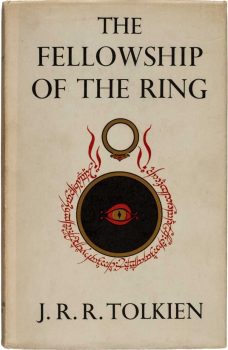 ‘I will take the Ring,’ he said, ‘though I do not know the way.’
‘I will take the Ring,’ he said, ‘though I do not know the way.’
Frodo from The Council of Elrond from The Fellowship of the Ring (1954)
I never saw it, but once upon a time, some hippies and ancillary types were given to emblazoning FRODO LIVES on bedroom walls and the backs of denim jackets. The Lord of the Rings, the literary creation of a conservative Oxford University professor of English Literature and Language, had somehow hit a chord with the nascent counterculture after its publication in 1954/1955. I imagine, in fact, I know, there are all sorts of popular and academic works purporting to explain why this was. I’ve never been interested in them, preferring the books themselves to present the professor’s ideas.
I have my own, if not particularly original, theories. First, it’s a great adventure story featuring a small, ineffectual-seeming hero who stands up to his world’s greatest force of evil. Second, it came to be seen as a sort of rallying cry against the dark powers of the modern world. I don’t know Prof. Tolkien’s politics, though I suspect he was a small-c conservative. It’s clear he viewed the loss of tradition and the dark Satanic mills blotting out the green and pleasant England of his youth were a terrible assault on civilization (this anti-modernist attitude is an important element of Michael Moorcock’s disdain for him). Third, the counterculture’s love for anything pastoral and ante-technological was probably the most important reason for its breakout into the mainstream’s consciousness.
I never discussed it with him, but I feel confident when writing that my father liked The Lord of the Rings primarily for the first reason and somewhat for the second (he was very much a BIG-C conservative) a bit. He most definitely did not like it for the last. When I first read it all that mattered to me was that first reason. With every revisit over the ensuing decades, I’ve discovered something new. That has carried on with my most recent reread.
For the handful of uninitiated out there, The Fellowship of the Ring (comprised of two books, Book I: The Ring Sets Out and Book II: The Ring Goes South), tells of the discovery that the magic ring Bilbo Baggins found in The Hobbit is really the single most evil artifact in the world and the start of the quest to destroy it. Bilbo’s heir, Frodo, and his gardener, Sam Gamgee, at the advice of the wizard Gandalf, set out for Rivendell. Following up on his suspicions about the ring, Gandalf spent over a decade hunting down the true nature of the ring. Finally, he determined Bilbo’s ring was the One Ring, the thing by which the Dark Lord (probably the first of such figures in fantasy fiction), Sauron, could seize control of all Middle-earth.
The four hobbits encounter numerous obstacles along the road to Rivendell of increasing peril. The most dangerous is their pursuit by the Nazgûl (Ring Wraiths). They are Sauron’s greatest servants, corrupted ages ago by lesser rings he made for Men.
In Rivendell, a plan is devised to destroy the Ring by dropping it in Mount Doom, the volcano it was originally forged in and the only thing that can destroy it. A party of nine, chosen from representatives of the different races of Middle-earth and led by Gandalf, set out toward the Dark Lord’s land, Mordor. Of course, things start going wrong right away. Before The Fellowship‘s end, two of the nine companions are dead, and the rest are split into three separate groups. I’ll leave it there. If you’ve read the books, you can fill in the blanks and if you haven’t, well, go fix that giant gap in what you’ve read.
 Moria by Alan Lee
Moria by Alan Lee
The book remains as enthralling to me as did when I first read it nearly fifty years ago. It’s filled with numerous scenes that filled me with awe on the first encounter that has never left me over the years. There are the monolithic Argonath, statues of ancient kings, standing watch over the borders of the kingdom of Gondor and the tree city of Caras Galadhon. The most striking thing was the ancient dwarven city of Khazad-dûm. I knew dwarves lived underground, but I hadn’t imagined anything like Moria. Like the nine companions, the readers are only given glimpses of Moria’s dark passageways, but they’re enough to convey its massiveness and harsh beauty.
Gandalf seemed pleased. ‘I chose the right way,’ he said. ‘At last we are coming to the habitable parts, and I guess that we are not far now from the eastern side. But we are high up, a good deal higher than the Dimrill Gate, unless I am mistaken. From the feeling of the air we must be in a wide hall. I will now risk a little real light.’
He raised his staff, and for a brief instant there was a blaze like a flash of lightning. Great shadows sprang up and fled, and for a second they saw a vast roof far above their heads upheld by many mighty pillars hewn of stone. Before them and on either side stretched a huge empty hall; its black walls, polished and smooth as glass, flashed and glittered. Three other entrances they saw, dark black arches: one straight before them eastwards, and one on either side. Then the light went out.
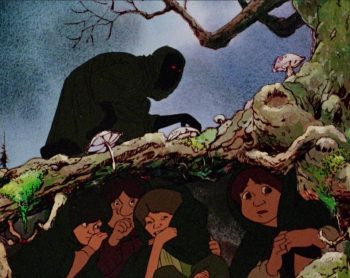 Ralphi Bakshi’s rotoscoped Ring Wraith and the hobbits
Ralphi Bakshi’s rotoscoped Ring Wraith and the hobbits
This time around, the outward journey of the hobbits, Frodo, Sam, Merry, and Pippin, from the bucolic seclusion of the Shire, by degrees, into the wider, wilder world they have been largely unaware of caught my eye. The first encounter occurs while still in the Shire when they hear the sound of hooves coming along the road.
The hoofs drew nearer. They had no time to find any hiding-place better than the general darkness under the trees; Sam and Pippin crouched behind a large tree-bole, while Frodo crept back a few yards towards the lane. It showed grey and pale, a line of fading light through the wood. Above it the stars were thick in the dim sky, but there was no moon.
The sound of hoofs stopped. As Frodo watched he saw something dark pass across the lighter space between two trees, and then halt. It looked like the black shade of a horse led by a smaller black shadow. The black shadow stood close to the point where they had left the path, and it swayed from side to side. Frodo thought he heard the sound of snuffling. The shadow bent to the ground, and then began to crawl towards him.
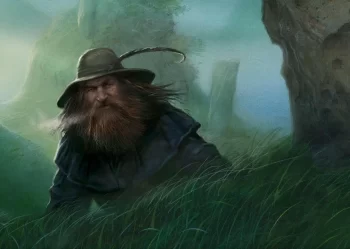 Tom Bombadil by John Howe
Tom Bombadil by John Howe
The second and stranger encounter occurs in the shadowed depths of the Old Forest. Once, many years ago, something from the Forest had somehow pushed back against the invading hobbits. In retaliation, the hobbits burned many of the trees and built a great hedge to keep the rest of them at bay. Once inside the dark woods, the hobbits are lured and trapped by an ancient, malicious willow tree only to be saved by one of the most divisive figures in fantasy – Tom Bombabil. Tom saves the hobbits again, as they continue away from their homes, and are trapped by evil spirits infesting ancient barrows. Their experience in the barrows gives visions to the hobbits, impressing on them the depths and width of the world outside their cozy borders.
This brings me to the second thing I paid more attention to on this reading: the moments of mystery and strangeness. Some hate Bombadil because he’s too frivolous. Others maintain he was just jammed into the story because Tolkien, who’d created the character for an earlier poem, liked him too much. I hold to the theory that for the whole first part of The Fellowship, Tolkien was feeling his way into the story, letting events grow spontaneously and I love the character, silly songs and all.
In the seemingly areligious Middle-earth (that’s a complicated bit of business for some other time, perhaps), Bombabil feels distinctly divine. He is married to the daughter of the river, “knew the dark under the stars when it was fearless – before the Dark Lord came from Outside,” and sings down the very stones of the haunted barrow. When asked about him, Tolkien responded that he was “not an important person – to the narrative” and that “he represents something that I feel important, though I would not be prepared to analyse the feeling precisely. I would not, however, have left him in, if he did not have some kind of function.” He alone, of everyone in Middle-earth, is impervious to the power of the Ring. It doesn’t work for him and he has no desire to own it. I love that there is no explanation for him, an element that doesn’t find an explanation in any of the vast history Tolkien composed for Middle-earth. To quote his wife, when asked who he is, she simply replies, “He is.”
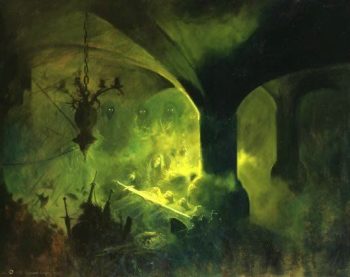 Barrow Wight by Paul Raymond Gregory
Barrow Wight by Paul Raymond Gregory
Being swallowed alive by a willow tree, evil or otherwise, is of course fairy tale strange. The haunted barrows and the capture of the hobbits by the barrow wights are more akin to the Germanic tales that partially inspired Tolkien. Trying to cross the downs, the hobbits find themselves imprisoned within one of the barrows. It is the eeriest point in the entire book, and could easily have been lifted from some skald’s ancient tale sung by the fireside.
As he lay there, thinking and getting a hold of himself, he noticed all at once that the darkness was slowly giving way: a pale greenish light was growing round him. It did not at first show him what kind of a place he was in, for the light seemed to be coming out of himself, and from the floor beside him, and had not yet reached the roof or wall. He turned, and there in the cold glow he saw lying beside him Sam, Pippin, and Merry. They were on their backs, and their faces looked deathly pale; and they were clad in white. About them lay many treasures, of gold maybe, though in that light they looked cold and unlovely. On their heads were circlets, gold chains were about their waists, and on their fingers were many rings. Swords lay by their sides, and shields were at their feet. But across their three necks lay one long naked sword.
Suddenly a song began: a cold murmur, rising and falling. The voice seemed far away and immeasurably dreary, sometimes high in the air and thin, sometimes like a low moan from the ground. Out of the formless stream of sad but horrible sounds, strings of words would now and again shape themselves: grim, hard, cold words, heartless and miserable. The night was railing against the morning of which it was bereaved, and the cold was cursing the warmth for which it hungered. Frodo was chilled to the marrow. After a while the song became clearer, and with dread in his heart he perceived that it had changed into an incantation:
Cold be hand and heart and bone,
and cold be sleep under stone:
never more to wake on stony bed,
never, till the Sun fails and the Moon is dead.
In the black wind the stars shall die,
and still on gold here let them lie,
till the dark lord lifts his hand
over dead sea and withered land.
He heard behind his head a creaking and scraping sound. Raising himself on one arm he looked, and saw now in the pale light that they were in a kind of passage which behind them turned a corner. Round the corner a long arm was groping, walking on its fingers towards Sam, who was lying nearest, and towards the hilt of the sword that lay upon him.
None of these moments make it into Peter Jackson’s film of The Fellowship of the Ring. They don’t serve the narrative thrust Jackson chose to focus on. What they do is help convey the transition of the hobbits — and the story — from the pocket world of the Shire to the real world, one beset by betrayal, ravaging armies, and supernatural evil. Taken together with the dangerous episodes, they serve as a sort of veil the hobbits, representatives of the traditional, insular England Tolkien loved, must pass through before the real quest — the one to destroy the Ring — can begin.
Which leads me to Jackson’s movie, The Fellowship of the Ring (2001). That’s in fact what started this whole undertaking. Even though I’m on record disliking the movies, I needed something on in the background while doing some work and something with swords and magic seemed the right choice. Within minutes I found my dislike bubbling up. Soon it was boiling over. The easiest solution was to just pick up the books and read them again — which I did.
The thing is, I kept watching the movie, quickly followed by the other two. It’s the closest I’ve come to really hate watching anything in my life. I’ll go into more detail when I get to The Two Towers and The Return of the King as they deviate the most from the books.
I don’t dislike the movies for things Jackson didn’t do. If Verdi can edit Shakespeare, Jackson can edit Tolkien. I understand leaving out all the things I described. While I think their elimination changes the nature of the story, removing them to speed up the film’s momentum makes cinematic sense. The movie is intended as an exciting, action-filled movie, not a travelogue. Characters are compressed or excised in service of fitting a large book onto the screen. It happens all the time, often quite successfully. And still, I dislike the movies.
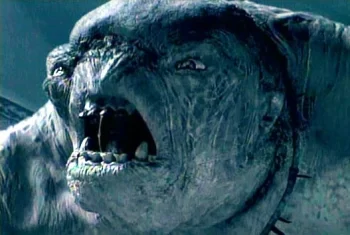 My easiest complaint is with filmmaking choices. First, are the moments of slow motion. Frodo getting stabbed and an uruk-hai running along a riverbank are the two moments that jump to mind most readily. They look cheap and terrible and stand out in a movie that lavished millions on looking good. Much worse is the fight and flight through Moria which becomes increasingly computer game-like as it proceeds. There is no architectural explanation that can possibly justify the staircase that collapses as our heroes are running down it. The battle in the book is much better choreographed and makes much more sense. Jackson’s camera work is skittery and nothing ever stays in a shot long enough to make much of an impression. The interaction between the characters and CGI troll looked fake twenty-plus years ago and only more so now. There are numerous other moments of interpretation I could argue about. Jackson always chose BIGGER and BOLDER, eschewing texture, subtlety, and atmosphere.
My easiest complaint is with filmmaking choices. First, are the moments of slow motion. Frodo getting stabbed and an uruk-hai running along a riverbank are the two moments that jump to mind most readily. They look cheap and terrible and stand out in a movie that lavished millions on looking good. Much worse is the fight and flight through Moria which becomes increasingly computer game-like as it proceeds. There is no architectural explanation that can possibly justify the staircase that collapses as our heroes are running down it. The battle in the book is much better choreographed and makes much more sense. Jackson’s camera work is skittery and nothing ever stays in a shot long enough to make much of an impression. The interaction between the characters and CGI troll looked fake twenty-plus years ago and only more so now. There are numerous other moments of interpretation I could argue about. Jackson always chose BIGGER and BOLDER, eschewing texture, subtlety, and atmosphere.
Tolkien’s Lord of the Rings isn’t devoid of humor. There’s Bilbo’s speech at his party and the discovery of the petrified trolls from The Hobbit. The thing is, there isn’t any slapstick. Not a bit. By which I mean especially pan-swinging, or dwarf-tossing. It’s awful and, like the slow motion, stands out in a movie that presents itself as a serious interpretation of a serious literary work.
My greater criticism is the film’s handling of the characters. Merry and Pippin are reduced to bad comic relief, instead of the clever conspirators who prove brave enough to maim and kill several orcs before Boromir is killed. Gandalf acts like a terrified fool in one moment and isn’t clever enough to solve the riddle to open the Gates of Moria himself. Boromir is more despicable seeming on the screen, instead of a man slowly being driven to madness by the Ring.
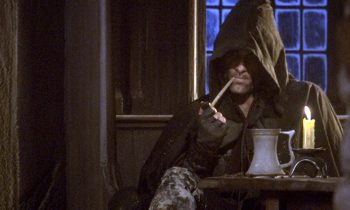 Most egregiously, Aragorn, born of an ancient line of kings, and raised to be a king, becomes a reluctant hero on the screen. We’re told he turned from the path of kingship long ago and later he says being king isn’t his goal. Aragorn is a man who has been a hero several times during his long life prior to the book, all for the purpose of opposing Sauron and restoring the kingship of a reunited kingdom. Finally, Elrond’s sworn he may only marry his daughter, Arwen, if he succeeds in his quest to become king.
Most egregiously, Aragorn, born of an ancient line of kings, and raised to be a king, becomes a reluctant hero on the screen. We’re told he turned from the path of kingship long ago and later he says being king isn’t his goal. Aragorn is a man who has been a hero several times during his long life prior to the book, all for the purpose of opposing Sauron and restoring the kingship of a reunited kingdom. Finally, Elrond’s sworn he may only marry his daughter, Arwen, if he succeeds in his quest to become king.
Instead of channeling the great heroes and chieftains of legend, Aragorn is reduced to, using one online site’s description, emo Aragorn. It feels like Jackson was incapable of believing someone could simply be portrayed as a hero, but needed to go on some sort of journey that almost forced him into choosing to be king.
There are loads of other things I don’t like about the movie. Most, though, are matters of taste, I suppose. Neither Viggo Mortensen nor Sean Bean are physically big enough or powerful enough for their roles. I don’t like many of the costumes, and I hate the portrayal of the hobbits as country bumpkins and Frodo is too young. The worst thing in the extended edition is the elf guard at Lothlorien’s five o’clock shadow.
I do like some things. Ian McKellen looks perfect. The Shire and the much of the wilderness countryside look like how I imagine they should. Galadriel taking on a terrifying visage when she imagines what she’d be with the One Ring is as exactly disturbing as it should be. Best of all, the death of Boromir, something that doesn’t come across as grandly tragic in the book as it should, is done brilliantly on the screen. That’s about it, though.
If this all seems a bit rambling, I’m sorry. Like last month, the spirit of Tolkien overpowered any original intentions I had. The result is this wandering around how The Fellowship of the Ring struck me on this tenth, or whatever it is, reading. I think I concentrated on those early chapters because excised from the movies, they are unknown to many who’ve never actually read the books. The book is much looser and messier than the movies and maybe that’s a reason I prefer it.
Fletcher Vredenburgh writes a column each first Sunday of the month at Black Gate, mostly about older books he hasn’t read before. He also posts at his own site, Stuff I Like when his muse hits him.
Alabama Writers Hall of Fame Class of 2025
The Alabama Center for the Book and the Alabama Writers’ Forum are excited to announce the Alabama Writers Hall of Fame Class of 2025! Tickets to the Awards Gala are on sale now!
Eight distinguished authors will be inducted into the Alabama Writers Hall of Fame at The University of Alabama’s Bryant Conference Center on Friday, March 7th , 2025.
The 2025 class inductees include Ace Atkins, Frye Gaillard, Joy Harjo, Janice Harrington, Robert McCammon, and Dr. Sue Brannan Walker. Authors C. Eric Lincoln and Brad Watson will be inducted posthumously.
Tickets can be purchased here.
The honor was first announced in May 2025. You can read about it here.
Comment on A Beginner’s Guide to Drucraft #30: Motion Sigls (II) by Valentin
I’am a little puzzled abouth this question: Is essentia effected by gravity?
If it wouldn’t, I guess it would have a hard time sticking to the earth, because it shouldn’t be effected by objects that aren’s drucrafters and earth is quiet quick. But if it is, I must wonder if there is essentia on the moon or the sun and then, due to sun’s enormous mass, it seams that there must be a realy big well in the sun. Is that right? Will we see space action in the series?
Roy Thomas and the Legacy of Conan the Barbarian
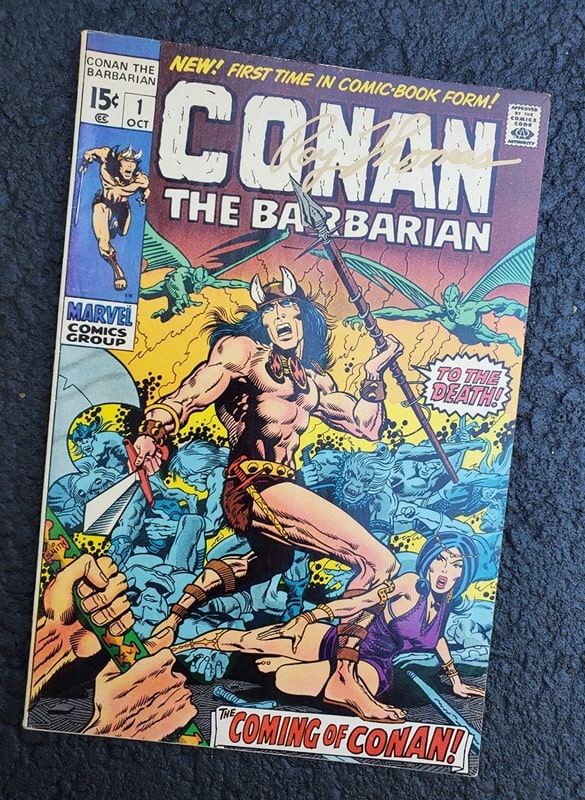 Conan The Barbarian #1 (Marvel Comics, October 1970). Art by Barry Windsor Smith
Conan The Barbarian #1 (Marvel Comics, October 1970). Art by Barry Windsor Smith
The package I received on July 6, 2020 brought me great joy! Roy Thomas is my favorite comic book writer. I correspond with him occasionally, and he is quite generous with his time, sharing his thoughts and memories. Very similar to how Gary Gygax did this, treating every fan with dignity and respect. A true gentleman.
I thanked Roy in my latest Hyperborea adventure book, The Sea-Wolf’s Daughter, because it included a character inspired by one of his creations. I sent him a copy of the book, and along with it my personal copy of Conan the Barbarian #1, to be signed by the author. Well, here it is! (He has an agency that normally handles this sort of thing, but he made an exception for me.) Excelsior!
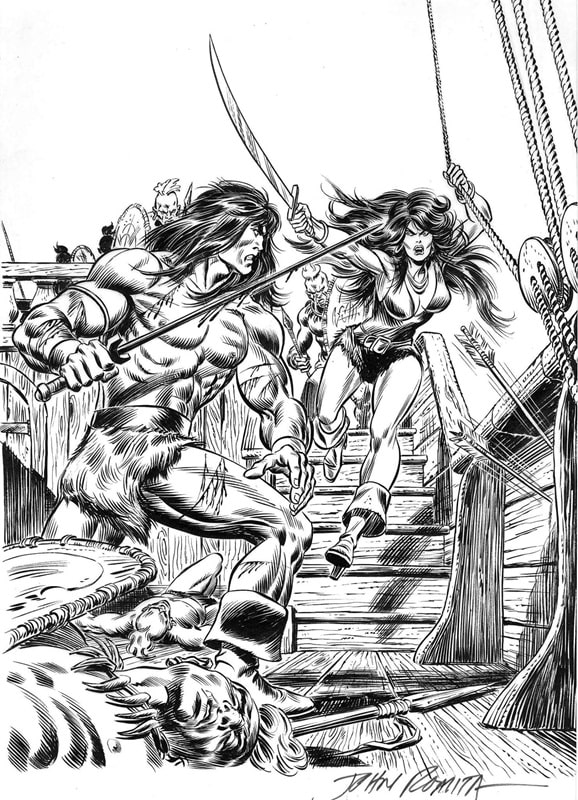 Cover art for Conan the Barbarian #58, by John Romita Sr., story by Roy Thomas (Marvel Comics, January 1976)
Cover art for Conan the Barbarian #58, by John Romita Sr., story by Roy Thomas (Marvel Comics, January 1976)
It is my humble opinion that of all the Conan pastiche writers, Roy Thomas is among the finest. But because he wrote in the comics industry, he’s often not afforded the same prestige as other Conan pastiche writers, such as L. Sprague de Camp, Lin Carter, Karl Edward Wagner, Robert Jordan, et al.
Thomas’ run starring Conan and Belit (the Queen of the Black Coast) started with this issue (#58) and concluded with the iconic issue #100. It is a treasure to read.
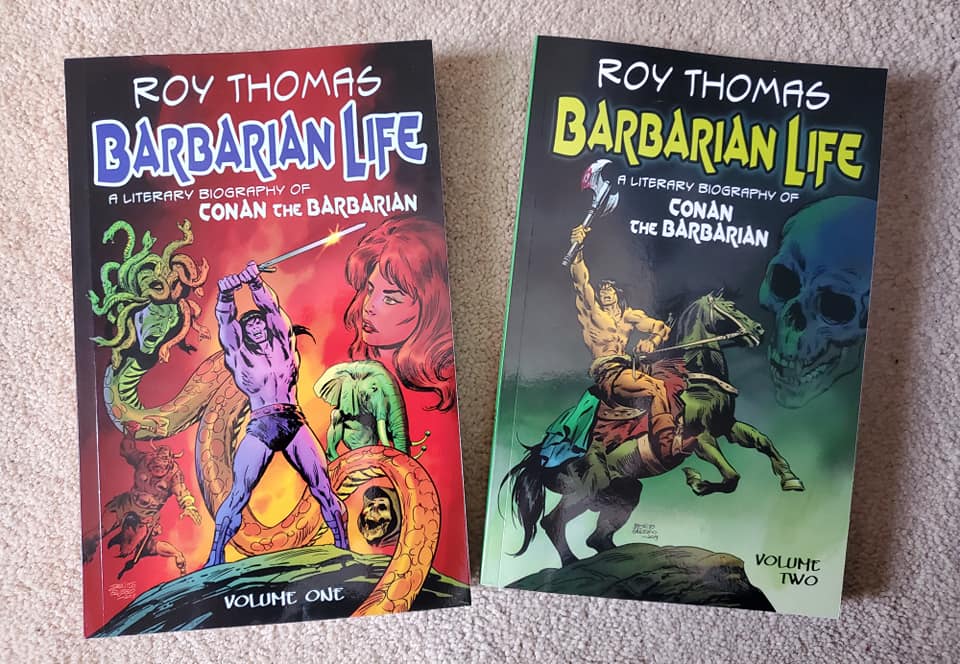 The first two volumes of Barbarian Life by Roy Thomas (Pulp Hero Press, December 7, 2018 and November 29, 2019)
The first two volumes of Barbarian Life by Roy Thomas (Pulp Hero Press, December 7, 2018 and November 29, 2019)
In the three volumes of Barbarian Life, Roy Thomas reflects on each of the first 100 issues of Conan the Barbarian, by Marvel Comics — which he wrote every issue of, from 1970 to 1979.
Roy is responsible for taking part in the creation of many Marvel and DC characters that have been featured in blockbuster films, but he will be the first to tell you that his favorite job was writing Conan the Barbarian, adapting and expanding on the works of Robert E. Howard and several other pastiche writers. What an incredible idea by Mr. Bob Mclain of Pulp Hero Press!
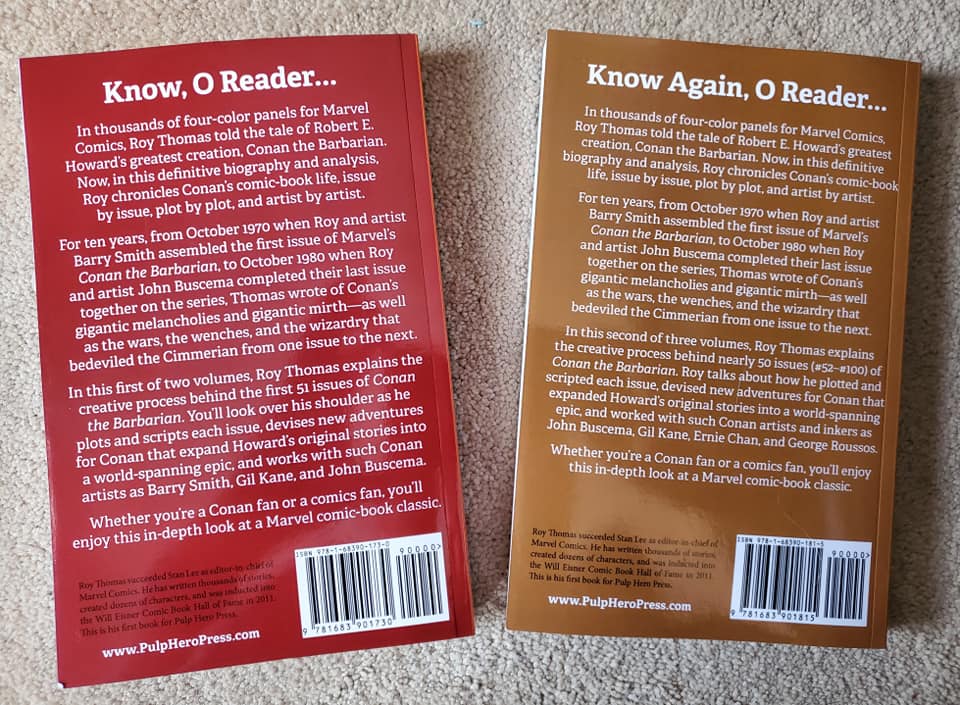 Back covers for Barbarian Life, volumes 1 and 2
Back covers for Barbarian Life, volumes 1 and 2
I can’t wait to dig into these two volumes; in fact, I have this crazy notion in me noggin about starting a blog in which I go through all 100 issues, reading the comic, followed by its respective chapter entry in the literary biography.
I’ve never blogged before, but I think this could be my motivation to give it a try in 2020. Would anyone be interested reading something like this?
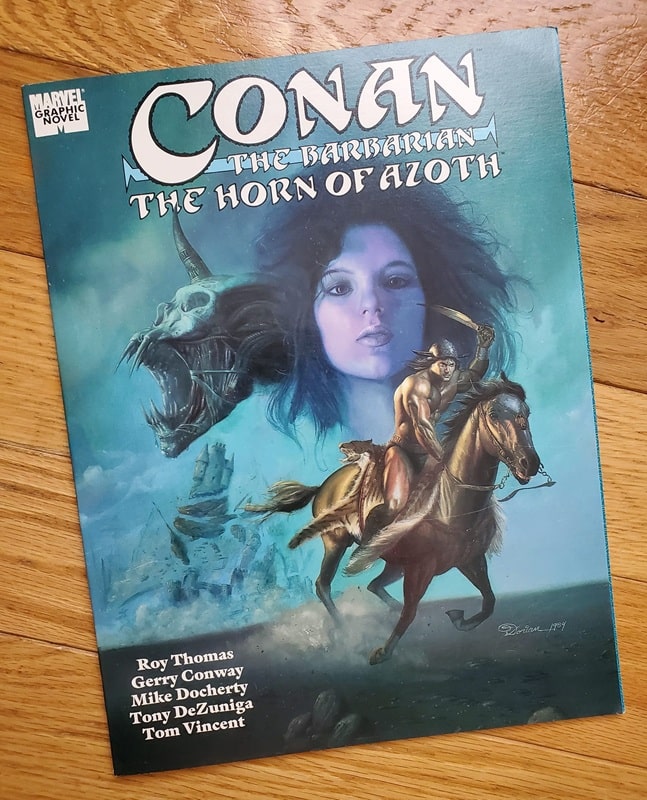 Conan: The Horn of Azoth, by Roy Thomas, Gerry Conway, Mike Docherty, Tony DeZungia, and Tom Vincent (Marvel Enterprises, January 1, 1990)
Conan: The Horn of Azoth, by Roy Thomas, Gerry Conway, Mike Docherty, Tony DeZungia, and Tom Vincent (Marvel Enterprises, January 1, 1990)
Above is Conan: The Horn of Azoth, aka Conan, King of Thieves, aka Conan the Destroyer.
Written by Roy Thomas and Gerry Conway, penciled by Mike Docherty, inked by Tony DeZuniga, and colored by Tom Vincent, this graphic novel, published in 1990 by Marvel Comics, has a fascinating publication history. For the complete history, definitely read the introduction by Thomas and Conway. What I am presenting is an abridged version of that story.
– It didn’t start off as a graphic novel; rather, it was the screenplay for the second Conan film, starring Arnold Schwarzenegger.
– In 1982, Universal producer Ed Pressman hired Thomas and Conway to write the script. Roy Thomas had previously worked as a consultant for the Conan the Barbarian.
– Roger Donaldson was to be the director.
– Barry Windsor-Smith was brought in to do concept art.
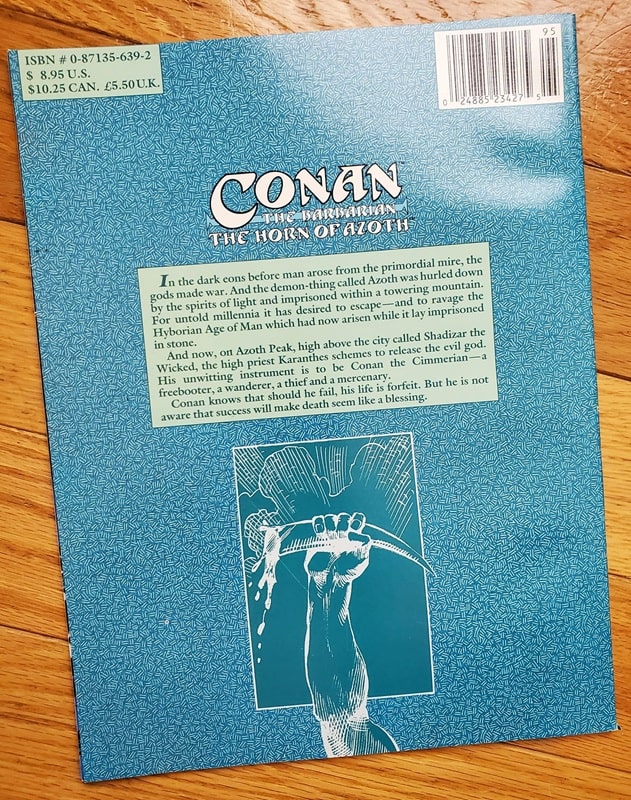 Back cover for Conan: The Horn of Azoth
Back cover for Conan: The Horn of Azoth
– Universal producer Pressman wanted it to be “lighter” (PG), so Thomas and Conway had to jettison some of their ideas. Result was their screenplay, Conan, King of Thieves.
– Pressman loved the screenplay, but sold his rights to Dino DeLaurentis.
– Dino was less familiar with REH and Conan, and he had his own ideas.
– The director, Donaldson, was removed. Dino wanted a lot of changes to the script. The storyline was continually adjusted.
– Dino hated leeches and rats and had them removed from the script. He wanted no stop-animation monster transformation, so the main monster had to be changed.
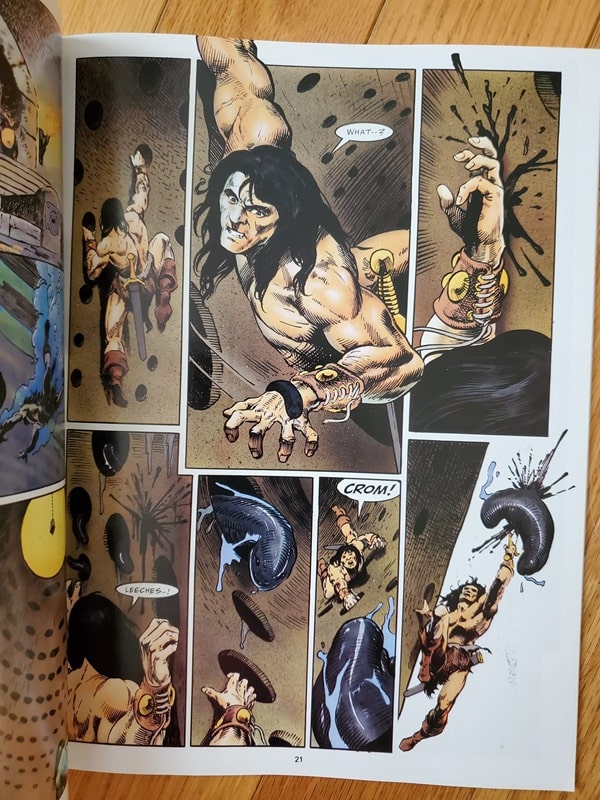
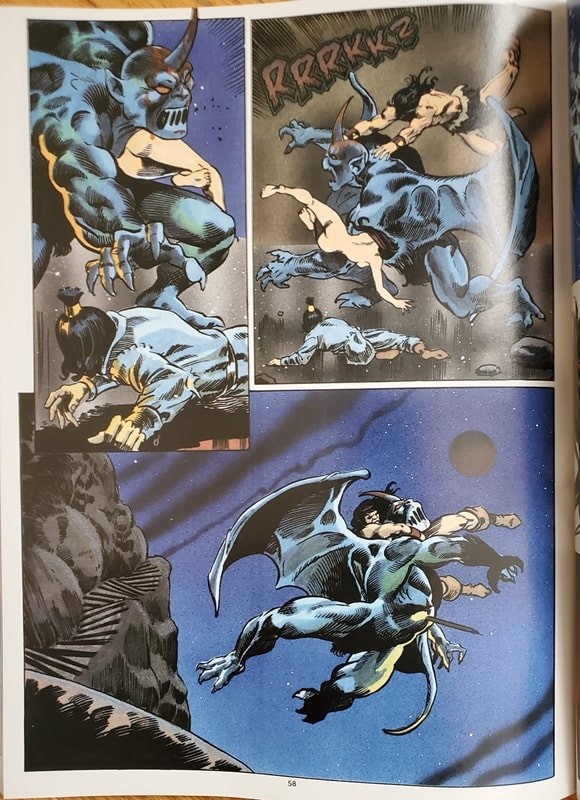
Interiors from The Horn of Azoth
– Richard Fleischer was hired as director. He came in with his own ideas and hired a new screenwriter to replace Thomas and Conway.
– Thomas and Conway had to fight for a screen credit in Conan the Destroyer. The Writers Guild decided that there were significant elements of the Thomas and Conway script that were retained, so they won.
– The original screenplay by Thomas and Conway was well-liked in the industry and led to further work for the two.
– Marvel editor Craig Anderson loved it, too, so they turned it from a 130-page screenplay to a 62-page graphic novel, published by Marvel.
And there you have it, Conan: The Horn of Azoth.
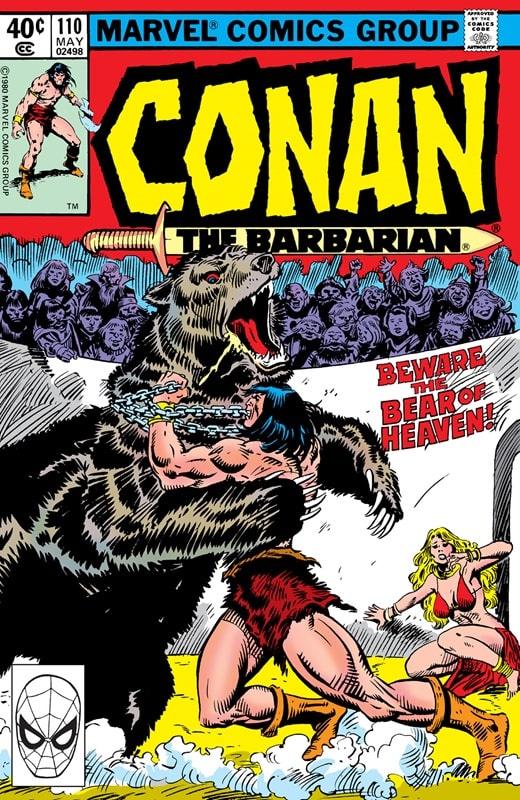 Conan the Barbarian #110, by Roy Thomas, John Buscema, and Al Milgrom (Marvel Comics, May 1980)
Conan the Barbarian #110, by Roy Thomas, John Buscema, and Al Milgrom (Marvel Comics, May 1980)
This is the first Conan the Barbarian comic that I ever read. Released in February of 1980 (with a cover date of May 1980), I would have been eight years old, soon to be nine.
I remember reading it over and over at my grandmother’s house, then redrawing it, too, making my own versions of Conan choking out a massive bear using a chain.
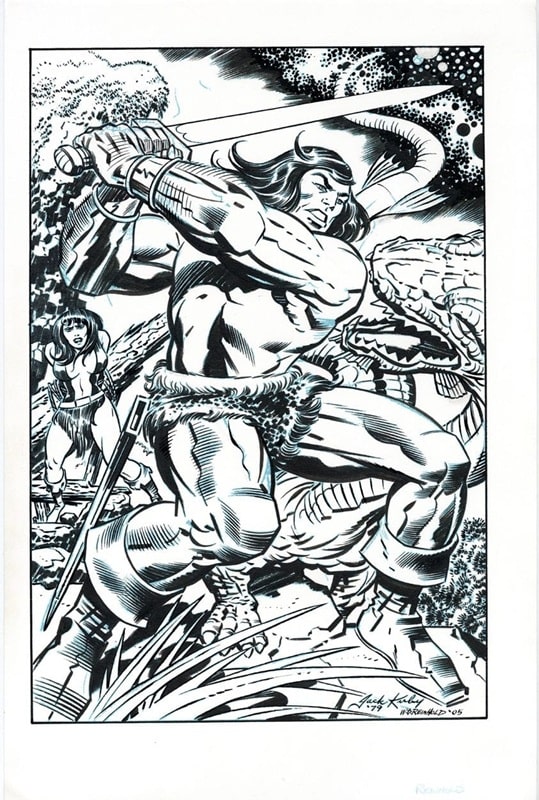 Conan by Jack Kirby
Conan by Jack Kirby
And here’s Conan the Barbarian, by Jack Kirby. Jack was not known for many Conan illustrations, but by Crom, this one is incredible.
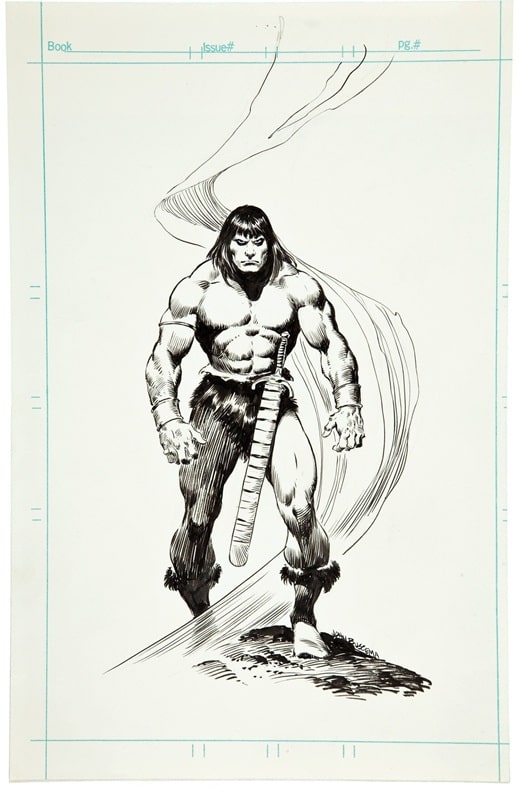 Conan by John Buscema
Conan by John Buscema
January 10, 2025 marked 23 years since the passing of the great John Buscema. His resume of artistic works is astonishing, to say the least, but for many of us (myself included), we will always remember him most for his Conan works (Conan the Barbarian, Savage Sword of Conan). When I read a Conan story (by REH or a pastiche author), and I picture Conan in my mind’s eye, I am seeing Big John’s rendition of the Cimmerian barbarian. Hail to John!
Jeffrey P. Talanian’s last article for Black Gate was The Intersection of Hobbies: Dungeons & Dragons, John Eric Holmes, and Tarzan. He is the creator and publisher of the Hyperborea sword-and-sorcery and weird science-fantasy RPG from North Wind Adventures. He was the co-author, with E. Gary Gygax, of the Castle Zagyg releases, including several Yggsburgh city supplements, Castle Zagyg: The East Mark Gazetteer, and Castle Zagyg: The Upper Works. Read Gabe Gybing’s interview with Jeffrey here, and follow his latest projects on Facebook and at www.hyperborea.tv.
Explore the Top 3 Rooftop Tents for Spring Camping 2025
As the weather warms up and nature beckons, spring camping becomes an enticing option for outdoor enthusiasts like you. Rooftop tents offer a unique way to experience the great outdoors, providing comfort and convenience while keeping you elevated and away from the ground. In this article, we will explore the top three rooftop tents for spring camping in 2025, helping you make an informed decision that enhances your outdoor adventures.
Top Picks- Best Overall: Naturnest Rooftop Tent – Andromeda Yellow – $999.00
- Best Value: Naturnest Rooftop Tent Hard Shell – Polaris 2 – $1,599.00
- Best for Families: Rooftop Tent Hard Shell – PEAKUNWIND – $1,999.00
When selecting the best rooftop tent for your spring camping needs, consider factors such as ease of setup, durability, weather resistance, and overall comfort. Each of these tents has been chosen based on their performance in these areas, ensuring you have a reliable shelter for your outdoor adventures.
Naturnest Rooftop TentThe Naturnest Rooftop Tent is your perfect companion for spring camping adventures. Designed for two, this tent offers a great view and excellent ventilation, making it ideal for stargazing or enjoying a gentle breeze while you relax. It’s lightweight at just 121 pounds, which means you can easily mount it on your vehicle without worrying about extra fuel consumption. Plus, it’s waterproof, windproof, and UV-resistant, ensuring you stay comfortable in various weather conditions. Whether you’re planning a weekend getaway or a longer road trip, this tent is a fantastic choice for both casual and serious campers.
What People SayUsers rave about the Naturnest Rooftop Tent’s ventilation and quality. Many appreciate how easy it is to set up and the comfort it provides, making it a favorite for outdoor enthusiasts.
-
My god, the ventilation and view of this tent are amazing. As you can see, it has doors and windows on all sides, and the top of the tent can also be opened. I drove to the suburbs and really tried to lie in the tent to see the stars. Guys, go outside and feel the nature. You will be grateful for it.
– GEORGE FREEMAN
-
I am impressed by the quality of this tent. The outer fabric is made of 420D Oxford cloth, which feels very thick and smooth, with no seam problems at all. It is completely waterproof, sun-proof, and completely blackout, providing a fully enclosed and safe interior space for outdoor camping.
– Julius Tayag
Pros:
- Excellent ventilation with multiple windows
- Lightweight design for easy transport
- High-quality materials ensure durability
Cons:
- Requires a vehicle with a roof rack for installation
- Great ventilation and view
- Lightweight and easy to install
- Durable and waterproof materials
Perfect for weekend camping trips, road trips, or even spontaneous outdoor adventures. The tent’s design allows you to enjoy nature without compromising comfort.
Current Price: $999.00
Rating: 5 (Total: 3+)
Naturnest Rooftop TentThe Naturnest Rooftop Tent is designed to elevate your spring camping experience. With a spacious layout for two, this tent not only provides a cozy spot to sleep but also offers stunning views and excellent ventilation. Weighing in at 185 pounds, it’s manageable for mounting on your vehicle, making it a practical choice for both weekend getaways and extended road trips. Plus, it’s built to withstand the elements—waterproof, windproof, and UV-resistant—so you can enjoy your adventures without worrying about the weather. Whether you’re stargazing or simply enjoying the fresh air, this tent is a fantastic addition to your outdoor gear.
What People SayUsers appreciate the Naturnest Rooftop Tent for its comfort and thoughtful design. Many highlight the ample storage options and the cozy mattress, making it a great choice for both casual campers and serious adventurers.
-
It is perfect for outdoor campers. It is very safe, the mattress is comfortable, the space is not too small, I think it can accommodate 2 people, it also has no condensation, and there are LED lights and multiple storage bags inside. Worth buying.
– lee jung ho
Pros:
- Comfortable mattress and spacious interior
- LED lights and storage bags enhance usability
- Durable construction for various weather conditions
Cons:
- Requires a vehicle with a roof rack for installation
- Spacious and comfortable for two
- Weather-resistant for all seasons
- Easy setup with thoughtful design features
This tent is perfect for weekend camping trips, spontaneous outdoor adventures, or even as a cozy retreat in your backyard. Its design allows you to enjoy nature comfortably, no matter where you are.
Current Price: $1,599.00
Rating: 5 (Total: 1+)
PEAKUNWIND Rooftop TentThe PEAKUNWIND Rooftop Tent is your go-to companion for spring camping adventures. With enough space for four people, this hard-shell tent is designed for comfort and convenience. Its Z-shaped design not only maximizes interior space but also ensures you can sit up comfortably without bumping your head. Setting it up is a breeze—just unlock the buckle, push up the ends, and let the air pressure rods do the work. Plus, it’s waterproof, UV-resistant, and built to withstand various weather conditions, making it perfect for both weekend getaways and longer trips. Whether you’re camping in the mountains or enjoying a night under the stars in your backyard, this tent is a fantastic choice.
What People SayUsers rave about the PEAKUNWIND Rooftop Tent for its spacious interior and hassle-free setup. Many appreciate the thoughtful accessories included, like the telescoping ladder and storage bags, which enhance the overall camping experience.
-
The Z-shaped design gives this rooftop tent plenty of space. I can sit and stretch without hitting my head, which is a huge plus. The extra room makes it perfect for longer trips.
– LEONARD W JOHNSON
Pros:
- Ample space for a comfortable camping experience
- Quick setup process saves time
- Includes useful accessories for convenience
Cons:
- Requires a vehicle with a roof rack for installation
- Spacious enough for four people
- Quick and easy setup
- Durable and weather-resistant materials
This tent is ideal for family camping trips, spontaneous adventures with friends, or even as a cozy escape in your own backyard. Its design allows you to enjoy the great outdoors comfortably, no matter where your travels take you.
Current Price: $1,999.00
Rating: 5 (Total: 3+)
FAQ What should I consider when choosing a rooftop tent for spring camping?When selecting a rooftop tent for spring camping, you should consider factors such as size, weight, and weather resistance. Ensure the tent can comfortably accommodate the number of people you plan to camp with. Look for lightweight options if you have a smaller vehicle, and prioritize tents with waterproof and windproof features to handle unpredictable spring weather. Additionally, check the setup time; a tent that can be easily assembled in under 10 minutes will save you time and hassle.
How do I maintain and care for my rooftop tent?To maintain your rooftop tent, regularly clean it with a mild soap and water solution to remove dirt and debris. Avoid harsh chemicals that could damage the fabric. After each use, ensure the tent is completely dry before packing it away to prevent mold and mildew. Store it in a cool, dry place when not in use. Additionally, inspect the seams and zippers periodically to ensure they are functioning properly and reseal them if necessary to maintain waterproofing.
Can I use a rooftop tent on any vehicle, and how do I ensure it fits my car?Not all rooftop tents are compatible with every vehicle, so it’s crucial to check the manufacturer’s specifications for compatibility. Most rooftop tents require a roof rack or crossbars that can support the tent’s weight. Ensure your vehicle’s roof can handle the combined weight of the tent and occupants. You can also consult with your vehicle’s manual or a professional to confirm the load capacity. If you’re unsure, consider visiting a local outdoor retailer for expert advice on fitting a rooftop tent to your specific vehicle.
Wrapping UpChoosing the right rooftop tent can significantly enhance your camping experience. The options highlighted in this article cater to various needs and preferences, ensuring that you can find the perfect fit for your adventures. Whether you prioritize comfort, value, or family-friendly features, these tents are designed to provide you with a memorable outdoor experience this spring.
Naturnest Rooftop Tent – Andromeda Yellow Naturnest Rooftop Tent – Polaris 2 Rooftop Tent Hard Shell – PEAKUNWIND

 Rating
5/5 (3 ratings)
5/5 (1 rating)
5/5 (3 ratings)
Highlights
Lightweight, waterproof, windproof, UV-resistant, 4-season tent for 2 persons.
Hard shell, easy setup, waterproof, windproof, UV-resistant, 4-season tent for 2 persons.
Hardshell, easy setup, blackout privacy, waterproof, UV-resistant, 4-season tent for 4 persons.
Pros
Excellent ventilation, great view, easy setup.
Comfortable mattress, spacious, no condensation.
Spacious interior, quick setup, sturdy design.
Cons
Higher price point.
Heavier than soft-shell options.
Most expensive option.
Price
$999.00
$1,599.00
$1,999.00
Buy Now
Buy Now
Buy Now
Rating
5/5 (3 ratings)
5/5 (1 rating)
5/5 (3 ratings)
Highlights
Lightweight, waterproof, windproof, UV-resistant, 4-season tent for 2 persons.
Hard shell, easy setup, waterproof, windproof, UV-resistant, 4-season tent for 2 persons.
Hardshell, easy setup, blackout privacy, waterproof, UV-resistant, 4-season tent for 4 persons.
Pros
Excellent ventilation, great view, easy setup.
Comfortable mattress, spacious, no condensation.
Spacious interior, quick setup, sturdy design.
Cons
Higher price point.
Heavier than soft-shell options.
Most expensive option.
Price
$999.00
$1,599.00
$1,999.00
Buy Now
Buy Now
Buy Now
The post Explore the Top 3 Rooftop Tents for Spring Camping 2025 first appeared on Rooftop Tents.
OUT NOW – The Unnatural Order (Schooled in Magic XXVII.
For generations, the Magicians of Celeste have chafed under at the limitations of the Compact, the treaties between the Magical and Mundane communities of the Allied Lands, and worked towards their abolition, envisaging a world in which magical supremacy would be established, allowing them to explore newer and greater fields of magic while keeping the powerless mundanes firmly under control. Their dreams were not taken seriously, until now.
With the end of the Necromantic Wars and the Allied Lands in disarray, they have finally stepped into the light and taken control of their city, declaring independence from the Allied Lands and creating a nightmare for both mundanes and any magicians who refuse to toe the line. And they don’t intend to stop. It is only a matter of time before they export their new regime to the rest of the continent, crushing anyone who stands in their way.
For Emily, who has traced the enigmatic Hierarchy to Celeste, there is no doubt that the new regime is an ally to a far older and darker threat. Millions of lives are at stake, thousands killed and tens of thousands more forced into slavery. The regime must be stopped, no matter the cost, before it imposes its own order on the entire world. But how can she prevail against an entire city of magicians, and a threat that has been decades in the making?
Download a FREE SAMPLE, then purchase: Amazon US, UK, CAN, AUS. Books2Read (other vendors). And read the Afterword here!

“The Lesson of the Master” and “The Master” | 2 Books in Conversation
Colm Tóibín, in his introduction to the 2007 edition of Henry James’ classic novella The…
The post “The Lesson of the Master” and “The Master” | 2 Books in Conversation appeared first on LitStack.
UNHALLOWED HALLS by Lili Wilkinson
Comment on New Beginnings by Rebecca Newsome
Great news. Cannot wait to read Book 3 and 4. Glad you are having fun with the writing!
Happy Hughday!
I know that the previous post was Chapter 2 Part 1 but it actually should be Chapter 1 part 2.
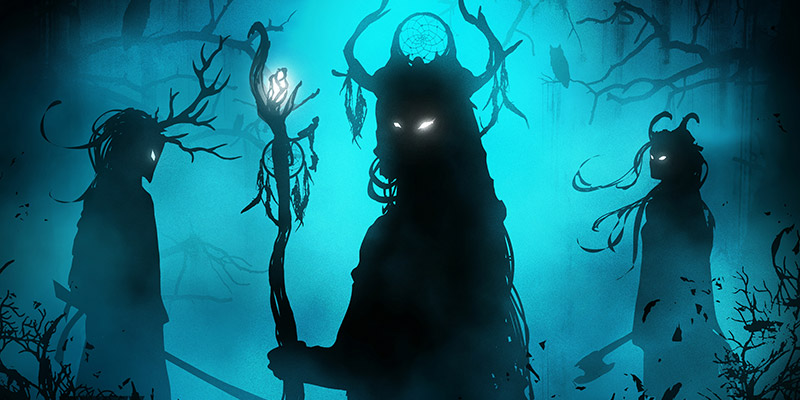 Chapter 2 Part 1
Chapter 2 Part 1
Druidism was a strange religion, Hugh reflected.
He stood on the edge of the hollow, his arms crossed. Around him the woods were waking up. Golden sunshine spilled from the early morning sky, setting the fall leaves aglow. Squirrels dashed through the branches, chittering at each other. A small herd of deer peeked through the gaps between the tree trunks.
On the other side of the hollow, Aidan Zhào, Dugas’s chief apprentice, studied the twine wrapped around the oak. He rubbed the twine between his fingers, smelled it, and rubbed it again. In the hollow, Fiona, another of the senior apprentices, lay down flat in her white robe, looking at the bones from the side, her face in the dirt. A third apprentice, whose name he couldn’t remember, crouched by some bushes.
Lamar came striding through the trees, carrying a thermos. The tall, lean centurion took in the scene, shook his head, and passed the thermos to Hugh. Hugh screwed the cap open and took a gulp. Coffee. Good, real coffee. Just what the doctor ordered. He saluted Lamar with the thermos.
Lamar nodded at the druid by the bushes. “What is he doing?”
“A rabbit showed up about ten minutes ago,” Hugh said. “They’ve been staring at each other ever since.”
Lamar blinked and pushed his glasses up the bridge of his nose. “Do you think he’s talking to the rabbit? Are they communing?”
Hugh just looked at him.
Aidan pulled the twine back from the tree trunk and released it like a rubber band. The twine sagged. Aidan tilted his head to the left, studying it.
Bale marched up. Five foot nine, with dark red hair and skin that burned from prolonged exposure to table lamps, Bale was built like a tank. Lamar, despite having four or five inches of height on Bale, was at least fifty pounds lighter. Standing side by side, they made an odd pair – one looked like he could scale a mountain without a rope and the other like he would punch his way through it.
The druids turned as one and waved at Bale.
He smiled and waved back. “I told you these guys were good.”
“Define ‘good’,” Lamar said.
Bale pointed to the druids. “Clearly they know their business.”
Aidan hugged the oak, thought for a moment, then turned around and splayed himself against the tree in a kind of backward hug.
“Yes, if that oak had arms, it would be hugging him back,” Lamar observed.
“These are my culture’s sacred traditions,” Bale growled. “Show some respect.”
Hugh raised his hand. The two centurions shut up.
Bale and Lamar never saw eye to eye. Lamar was a strategist who thought a lot and said little, while Bale blurted out whatever came into his head as soon as it occurred to him. Left unchecked, they would bicker, and Hugh didn’t have time for that.
He’d taken Elara and Savannah, their head witch, to the site in the middle of the night. Neither his wife, nor Savannah, had any idea what the bones were. After some discussion, the three of them agreed that at first light, they needed to get the Dugas’ druids on site. He had gotten zero sleep.
The druid by the bushes went down on all fours, lowered his head, and swiveled it side to side. A large rabbit popped out of the bush, rubbed its head on the druid’s head, and scampered off.
“Bale, I swear by all that is holy, if they start singing to the woodlands creatures, I’m out,” Lamar said.
“If you don’t want to be here, just go.” Bale shrugged his massive shoulders. “Otherwise, be quiet. You might learn something.”
The druids came together, spoke in hushed tones, and then approached, Aidan in the lead.
Hugh braced himself. “Yes?”
“It is druidic,” Aidan said. “It wasn’t done by any of us.”
“How do you know this?” Hugh asked.
“It is druidic because druidic implements were used in creating this site,” Aidan said. “It is not any of us, because they used stinging nettle twine. I am allergic to it.”
He held up his hand, showing reddish fingers and welts on his palms.
“We use dogbane twine,” Fiona said. “Stinging nettle is an invader, while dogbane is native to the continent.”
“So does this mean it’s a European druid?” Hugh asked.
“It could be,” Aidan said. “We tend to use what’s natural and familiar to us.”
“However,” Fiona said. “Some people are traditionalists. They import their supplies.”
“If someone bought stinging nettle twine, we would know,” Aidan said. “All of our supplies are locally harvested and communal. Unless someone is hiding covertly purchased twine under their bed, it wasn’t one of us.”
“So the culprit could or could not be a European druid and they are probably but not certainly not one of you?”
“Yes,” Fiona confirmed.
Wonderful.
“It’s bad,” the rabbit druid said.
Hugh looked at him.
“It goes against Dugas’ teachings,” the rabbit druid elaborated. “We’re meant to be one with nature, not to tame or conquer it. This magic is imposing human will onto nature. Changing it, twisting it. The rabbits do not approve.”
Bale nodded sagely.
“Did the rabbit see who might have done it?” Lamar asked.
The rabbit druid looked like him as if Lamar was a toddler asking to drive a car. “We all look the same to them. They are only rabbits, after all.”
Hugh rubbed his face.
“Could you come with me?” Aidan asked.
Hugh followed him to the oak.
Aidan pointed to a shallow scratch on the bark. “We know that the twine was wrapped around the tree right here, about thirty-two inches off the ground.”
The senior apprentice nodded, and the two other druids wrapped the twine around the trunk matching the scratches on the bark and held the edges of the twine together. Aidan hooked the twine with his fingers and pulled it from the tree.
“As you can see, it is wrapped exactly twice around the trunk. But we have all this slack.”
And there it was, the worst-case scenario.
“Is the twine lubed with fat?” Hugh asked.
“It is. I’m so sorry,” Aidan confirmed.
Figured.
“Fuck,” Bale said.
“Exactly,” Aidan said.
“Was something bound to the trunk?” Lamar asked.
“Show him,” Hugh told them.
Fionna sat by the roots of the tree, her back against the trunk. Aidan wrapped the twine around her neck and wound it back around the tree. The cut ends matched perfectly.
“Human sacrifice.” Lamar hissed the words.
“We must confer with our master,” Fionna said. “This is not permitted in our domain.”
Sacrificing a human was done primarily for two reasons: as a tribute or a trade. The first was done as an offering to the gods; the second, to acquire a massive boost in power, usually for a specific purpose. And they had no idea what that purpose was.
An Iron Dog came running through the woods.
“Yes?” Hugh asked.
“A messenger from Aberdine, Preceptor. They are waiting for you.”
When it rained, it poured.
Hugh looked at the druids. “Tag it, bag it, and undo as much of this as you can. Bring it all to Bailey and quarantine it.”
The druids nodded in unison. He turned around and headed back toward the castle to put out whatever new fire was waiting for him there.
It was going to be a long day.
The post Happy Hughday! first appeared on ILONA ANDREWS.
Comment on A Beginner’s Guide to Drucraft #30: Motion Sigls (II) by Kevin
In reply to Benedict.
Ah okay I just assumed he used a Motion sigl in the raid since he went really fast against the raiders and I thought it was a Motion sigl like Lucella was using to escape.
Would it be safe to say the Motion sigl they used are better for long distances and the reflex enhancer is better for short bursts/close encounters with enemies?
Comment on A Beginner’s Guide to Drucraft #30: Motion Sigls (II) by Benedict
In reply to Kevin.
Calhoun’s specialities are Light and Motion, but he’s a highly skilled drucrafter and, just like Stephen, he’s fully capable of using sigls from his ‘weak’ branches, too. He has a reflex-enhancing Life sigl that he carries when expecting trouble (and at other times as well).
Midnight Rambles: H.P. Lovecraft in Gotham by David J. Goodwin
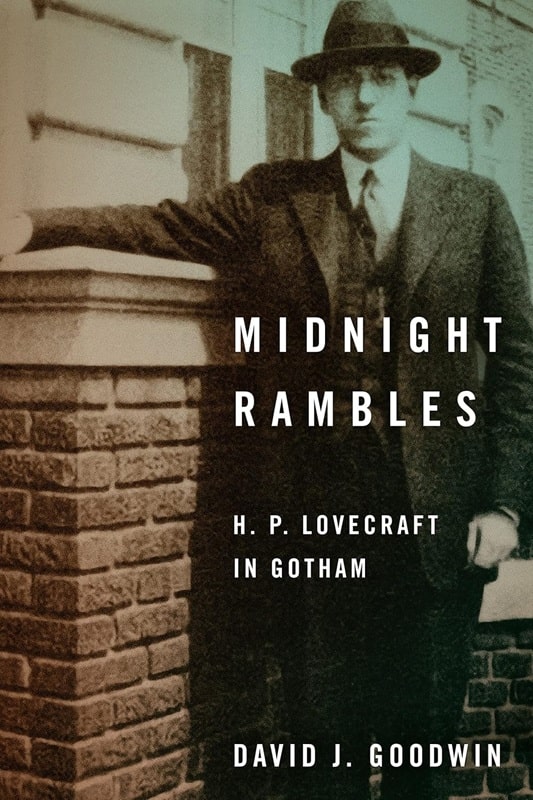
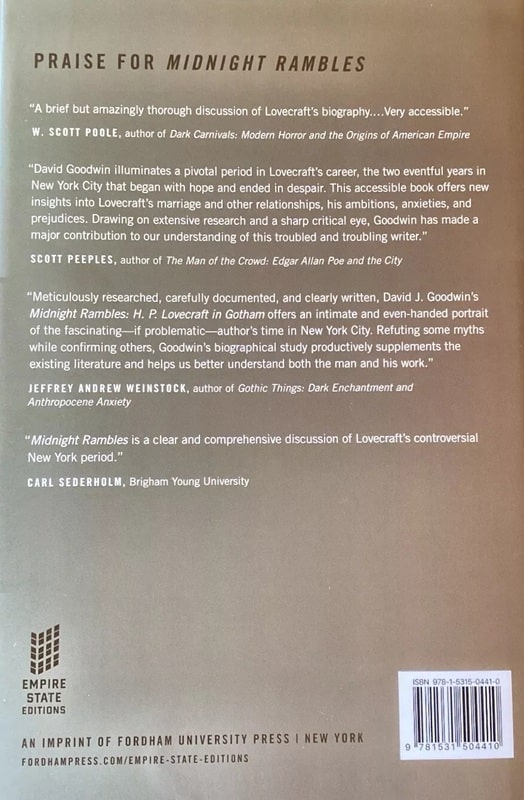
Midnight Rambles: H.P. Lovecraft in Gotham (Empire State Editions, November 7, 2023)
David J. Goodwin’s Midnight Rambles: H.P. Lovecraft in Gotham provides a narrow and deep slice of H. P. Lovecraft’s biography, detailing his personal and professional life during the few years he lived in New York City. Deeply researched and full of connections, Goodwin provides correction to some long-held Lovecraft biographical details and does not flinch from detailing Lovecraft’s innate hostility to non-WASP groups, ably describing it in the context of a deeply racist and anti-semitic society.
There are very few people who can claim to be expert on the life and work of H.P. Lovecraft, and Goodwin’s book puts him in range of that small number (such as S.T. Joshi). As he’s written and presented about Lovecraft more than half a dozen times, Goodwin seems poised to rise to stand among the critics named when the storied and controversial author rises in conversation, if he’s not there already. Learn more about Goodwin here.
Goodwin faces a difficult biographical subject in writer H.P. Lovecraft. Much material of signal importance during this time is unavailable. His spouse, Sonia Greene, destroyed some 400 of Lovecraft’s letters, largely from the period of interest for this text. Lovecraft’s aunts, demonstrably hostile to his marriage to Greene, discarded dozens of postcards when Lovecraft moved to New York through the simple expedient of giving away everything he had not specifically requested be sent to his new lodgings in the city. These details sample the rich trove of information about Lovecraft in Goodwin’s text.
Despite these holes in the biographical record, Goodwin’s ample research buttresses his assertions about the writer’s experiences in Gotham. The period constitutes a fertile time for Lovecraft, a locus that saw the invention of what would later be called the Cthulhu mythos. That it also saw the creation of the author’s least palatable, racist fiction represents an unavoidable truth. For each of the Lovecraft stories written during his residence in the city, Goodwin provides detailed research that helps illuminate the influences likely to have pressed upon the author. However, the biographer also includes historical demographic information to fully contextualize the lack of basis for any of Lovecraft’s many claims, a thread illustrating Lovecraft’s self-mythologizing nature.
The architecture of houses, the urban design of towns and cities was always of interest to Lovecraft, who, Goodwin explains, ambled extraordinary distances to view places and structures of interest. Readers familiar with John Crowley’s Little, Big may notice a reference to a real life builder important to New York that appears in that fictional text.
Lovecraft’s relationship with Sonia Greene merits several chapters and encapsulates their meeting, courtship, sudden marriage, and ultimate divorce that neatly marks the end of Lovecraft’s time in the city. Goodwin works wonders with the limited material available on this window to the past and readers familiar with Lovecraft biographies of broader scope will find material of interest in these pages. It is here Goodwin provides the price of admission for this text. Owing to an absence of a signed decree of divorce, past biographers have stated the author failed to sign those papers, meaning Greene’s subsequent marriage in California was bigamous.
Goodwin effectively implodes this “never signed” myth with solid evidence to the contrary, noting in addition that the loss of legal documentation was not uncommon in the 1920s. This conclusion is an exception among many assertions buttressed with the language of guesswork. Of all the guesses in Midnight Rambles, none struck this reviewer as unlikely or a reach. The biographer confines himself to likely scenarios, allowing for the many connections to form a compelling web to wrap these Lovecraft years for readers.
Readers interested in Lovecraft will find Midnight Rambles required reading. In this readable and at the same time admirably academic work (the two do not always meet amicably) even casual readers of Lovecraft may find information of interest. While Lovecraft expressed vehement racist and anti-semitic views, he married a Jew. While holding typical for the era dislike for homosexuals, one of his New York City walking buddies and long time correspondent was gay. Understanding this author, who some say serves as the pennant-waver for American horror fiction in sequence after Edgar Allan Poe, is made easier by Goodwin’s work. I recommend it to Lovecraft enthusiasts and any who find interest in the literary history of Gotham, our style and fashion capital.
Edward Carmien’s last article for Black Gate was When Your First Language is Role-Playing Games. His short stories “Before the Wind” and “Knives Under the Spring Moon” appeared in the print version on Black Gate in 2007 and 2008. He maintains a daily blog on writing at edwardcarmien.wordpress.com

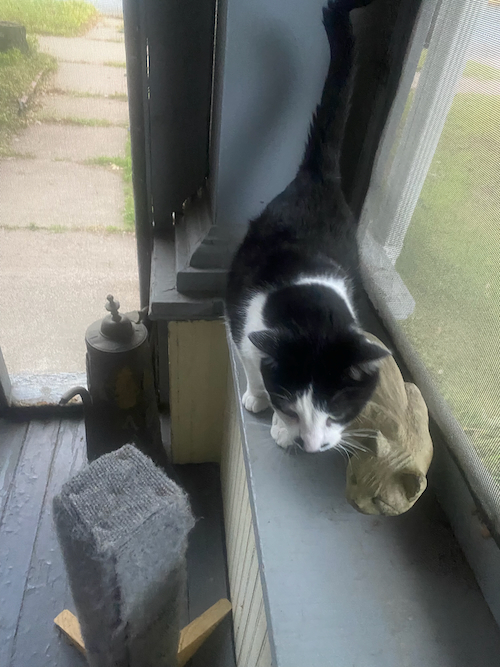
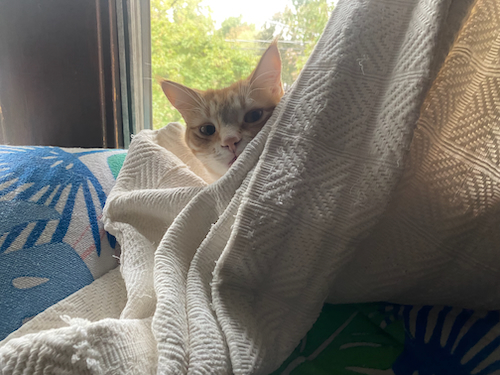



Recent comments